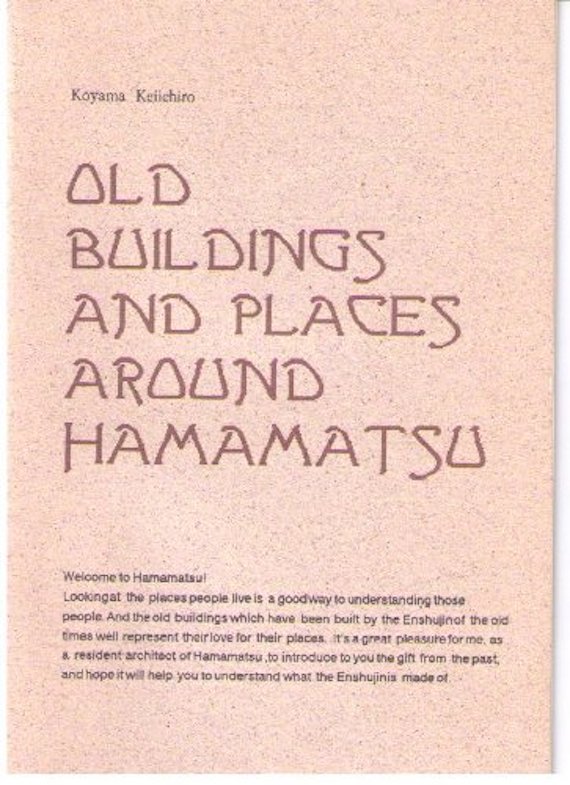This is a pamphlet I wrote in 1991, revised and enhanced.
It was a study of then published software named "PageMaker".
I found .txt formatted files for "History", "01Central Area" and "02Sanaruko" in my HD.
Other files were saved in .pmd and there is no way to open them. I will replace them with newer findings.
I will try to write them after Ando Hiroshige's "53 stations along Tokaido".
People in older ages have no way than walk on their foot and this brings you of so many things than go on cars or shinkansen.
If you walk on your feet, there are so many findings about what has changed from Hiroshige days and what don't cchange.
I feel happy if you copy and use it freely as a part or whole. I owe no responsibity from it's quotation.
7.1 2021
KOYAMA Keiichiro
〒430-0946
109-12 Motoshiro-cho
Hamamatusi
JAPAN
古山恵一郎
〒430-0946
浜松市元城町109-12
tel: 070-3140-1432
fax: 053-488-8433
e-mail:
ask@tcp-ip.or.jp
まちづくり
History
1 Central Area
__contd.
2 walk to Sanaruko
3 Imagire
4 Arai
5 Hashimoto
6 Washidu
7 Shiomizaka
8 Futagawa
e1 Kakegawa
e2 Kotonomama
e3 Sagara

History
Don't feel puzzled if you can't imagine the Old City of Hamamatsu.
Sometimes I have difficulty also but let me try and help you with a little background.
Once upon a time, there were hills of deep green leaves. From the top of tall trees, wide ocean holizon spreaded to the south and white snow on the summit of a cone shaped mountain greamed in distance east. Gandpa gathered firewood on the hills.Gandma washed closes and food by the stream. Shellfishes were everywhere in the muddy seawater which rose to high tide between the green hills in those times. They ate shellfish for years after years. And the shells piled high around their villages.
You can see the pile of the shells at the Shijimizuka Iseki, remains of a village some 3,000 years ago. Historical Museum is now beside the remains. And you can learn the history of Enshu there.
There is anothere remains of a village which goes back some 2,000 years ago . Iba Iseki is believed to had been an important state horse-station for centuries untill the Middle Ages.
Through the days of the Samurai Wars, Enshu had been an important strategic corridor. Lords of the West were forced to conquer this land to go further to the East and forces of the East must take it to go up to the Capital of Kyoto. After stationing here for years, Tokugawa Ieyasu finaly won the war at the beginning of the 17th century.
Through the Edo Era untill 1868, Hamamatu had been one of the Fifty -Three Stations along Tokaido highway. Daimyos were posted as governers of the castle. Samurai resided around the castle and merchants gathered to accomodate official travellers and others .
Farmers from the villages nearby were forced to labour for the station instead of the tax.
Unlike the castle cities of China or Europe, there weren't walls surrounding the houses but wooden gates at points along the highway instead. One at Kido-cho and the other at Naruko-cho along Tokaido. Anothere was at Kameyama-cho just north of the castle.
Tokaido was an official place in those days. Only authrized inns (Honjin was the first classed inn for the Daimyo.) and large stores opened along its path.
Sakanamachi and Chitosecho, as back streets to Tokaido were more easy quarters and perhaps amused travellers and townsmen day and night.
At the fall of the Tokugawas in 1868, Hamamatsu's population within the town gates was about 21,000. Since then, people from not only the nearby villages but places much further began to gather around Hamamatsu.
After the completion of the Tokaido railway and Hamamatsu railway station, modern industries and other businesses boomed near the railway station.
When the World War II broke out, there were so many industrial facirities for miritaly purposes including an air base in Hamamatsu. This caused several air raids and at the end of the war, most of the central area of the city had been burt down togather with many great old wooden buildings.
After the war and along with the industrialization of the country, Hamamatsu continued its progress till today.
1 Central Area